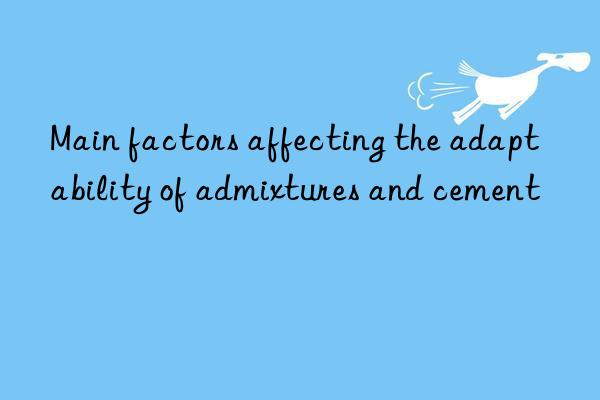
The mineral composition of concrete
The mineral composition of concrete depends on the manufacturer’s differences in raw materials, processing techniques, etc. Very different. The main components of cement clinker in China's large, medium and small chemical plants vary greatly. The C3S water content may be about 1 time different, and the C3A water content may be 6 times different. The mineral composition of cement clinker from the same manufacturer will also fluctuate. According to a survey in a certain year, about 50% of manufacturers have C 3 S fluctuations within ± 2.5%, and 50% of manufacturers have C 3 A fluctuations within ± 1%. About 70%; according to the isothermal adsorption of cement clinker mineral components C 3 S, C 2 S, C 3 A, C 4 AF to lignocalcium ions, their adsorption level of lignocalcium water-reducing agent It is: C 3 A > C 4 AF > C 3 S > C 2 S. It can be seen that the adsorption level of aluminate phase minerals on wood calcium exceeds that of silicate phase minerals. Because C 3 A selectively adsorbs calcium lignosus, the adsorption capacity is significantly increased, which will reduce the water-reducing effect of the water-reducing agent. Therefore, under the condition of the same dosage, in cement mortars with higher moisture content of C 3 A and C 4 AF, the refining effect of the water reducing agent is weaker. C 3 A has a low moisture content and C 3 S has a lower moisture content. High concrete has good adaptability to wood calcium superplasticizer. The adsorption level of several major mineral components on naphthalene series and polycarboxylate series water-reducing agents needs to be further studied.
Adjustable lime paste in concrete
When grinding cement clinker, usually A sufficient amount of lime paste is added and ground together, and then the lime paste plays the role of adjusting the initial setting time of the concrete. Because during the grinding process, the temperature inside the mill rises, causing a small part of the dehydrated lime plaster to take off the crystal water and change it to semi-hydrated lime plaster, or take off all the crystals and turn it into anhydrous gypsum. On the other hand, in order to save product costs, some chemical plants choose anhydrite (anhydrite) or manufacturing by-product lime plaster (both anhydrous gypsum) to replace dihydrate lime plaster as the concrete setting agent, and carry out the work in accordance with relevant concrete standards. The difference is usually very small during product quality inspection. However, when water-reducing agents are added, they sometimes show completely different effects. Especially when concrete that uses anhydrous gypsum as a setting agent encounters calcium lignocellulosum and sugar-calcium water-reducing agents, serious consequences may occur. Without the ability to adapt, not only will the expected water-reducing effect be lost, but it will also cause excessive swimming damage and even abnormal initial setting (rapid setting, false setting).
Due to the different shapes of lime plaster crystals, their adsorption potential for lignocalcium and sugar calcium superplasticizers is also different. The order is: CaSO 4 > CaSO 4 · 1/2H 2 O>CaSO 4 · 2H 2 O. When adding lignocalcium or sugar calcium water-reducing agent to concrete using anhydrous gypsum as the setting agent, and then mixing it with water, the surface of the anhydrous gypsum will immediately absorb a large amount of lignocalcium or sugar calcium ions, resulting in water reduction. The agent adsorption film layer tightly surrounds the anhydrous gypsum, making it unable to dissolve the SO ionization required by the cement mortar, and cannot quickly produce a large amount of ettringite on the surface, thus resulting in C 3 A Too much hydration results in the formation of an equal number of connected calcium aluminate hydrate crystals. This result may cause the concrete slump to deteriorate too quickly, or cause the concrete to set abnormally quickly. The key factors affecting the adaptability of concrete and water-reducing agents to lime plaster are the following four levels:
(1) Lime plaster particle size. Insufficient particle size of the lime paste results in insufficient solubility of the lime paste, resulting in rapid setting.
(2) Lime paste dosage. Insufficient dosage of lime paste to allow proper control of C 3 A hydration.
(3) Lime plaster shapes and types. - Generally, the setting effect of CaSO 4 · 2H 2 O in concrete is better than that of CaSO 4 · 1/2H 2 O and anhydrite. The harm of the shape of lime paste in concrete to the application of superplasticizer is related to the mass fraction of C 3 A in concrete. When the mass fraction of C 3 A is high, the harm is great, and then it is small. The important parameters affecting the rheology of concrete and superplasticizers are: the balance between the amount of highly electropositive interstitial phase zone activity and the rapidly soluble SO. If the balance between these two values is appropriate, the water-reducing agent and concrete have good adaptability.
(4) Lime paste polishing temperature. Generally speaking, in order to reduce the cooling time of clinker, chemical plants often grind the relatively high temperature clinker and lime paste at the same time. Dihydrate lime paste can be dehydrated into semi-hydrated lime paste at a high temperature of 150 ℃. When the temperature reaches about 10°C, semi-hydrated lime plaster will also turn into anhydrite with weak solubility, which will affect the adaptability of concrete.
Cement fineness and concrete particle shape
</p



 微信扫一扫打赏
微信扫一扫打赏
